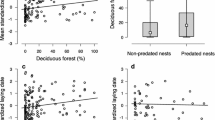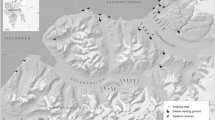Abstract
One of the most striking behavioural adaptations for reducing nest predation is nesting near a top predator. However, in spite of increasing number of studies in forested landscapes reporting reproductive success benefits when nesting near protective associates, studies examining whether protective effects vary with food availability for the top predator are lacking. We asked whether the nest predation on ground nests of birds in Ural Owl (Strix uralensis) territories is dependent on varying food conditions for the owl. This was studied using dummy nests placed at different distances from the Ural Owl nests and repeating the study in different food conditions for the owls (low, increase and peak phases of the vole cycle). The proportion of predated dummy nests differed between different food conditions for Ural Owls being lowest in a low vole year. The distance from the owl nest affected the predation of dummy nests, but only in intermediate food conditions. Due to the lack of control nests located outside the owl territories, we are not able to draw conclusions about the background variation in the nest predation in different food conditions. We hypothesise that fluctuating prey availability for the top predator species under concern may have significant effects on the outcome of species interactions. This currently unexplored idea should be tested further, e.g. by including multiple breeding seasons in the future studies on protective nesting associations.
Zusammenfassung
Eine der auffälligsten Verhaltensadaptationen zur Verringerung von Nestprädation ist das Nisten in der Nähe eines Top-Prädators. Obwohl die Anzahl von Untersuchungen welche reproduktive Vorteile des Nistens nahe bei schützenden Arten beschreiben, zunimmt, fehlen Studien über diesen Effekt in Abhängigkeit von der Nahrungsverfügbarkeit für den Prädator. Hier untersuchen wir ob Nestprädation von Bodenbrütern in Territorien von Habichtskäuzen (Strix uralensis) von der Nahrungsverfügbarkeit für die Käuze abhängig ist. Wir Nestattrappen in unterschiedlicher Entfernung von Habichtskauznestern platziert, und diese Untersuchung zu Zeiten unterschiedlicher Nahrungsverfügbarkeit für die Habichtskäuze (geringe, zunehmende und maximale Phase des Wühlmauszyklus) wiederholt. Der Anteil prädierter Nestattrappen war variabel in Jahren mit unterschiedlicher Nahrungsverfügbarkeit, und am geringsten in Jahren mit geringer Wühlmausdichte. Der Abstand zwischen den Kautznestern und der Nestattrappe hatte nur in Jahren mit mittlerer Nahrungsverfügbarkeit einen Effekt auf Nestprädation. Aufgrund des Fehlens von Kontroll-Nestattrappen außerhalb von Habichtskauzterritorien konnten wir keine Rückschlüsse auf Hintergrundvariation der Nestprädation in unterschiedlichen Jahren ziehen. Wir schlagen vor das eine fluktuierende Beuteverfügbarkeit für den Topprädator signifikante Effekte auf die Interaktionen zwischen Arten haben kann. Diese derzeit noch wenig erforschte Hypothese sollte in Zukunft explizit und in mehreren Jahren getestet werden.



Similar content being viewed by others
References
Bêty J, Gauthier G, Giroux J-F, Korpimäki E (2001) Are goose nesting success and lemming cycles linked? Interplay between nest density and predators. Oikos 93:388–400
Halme P, Häkkilä M, Koskela E (2004) Do breeding Ural owls Strix uralensis protect ground nests of birds?: an experiment using dummy nests. Wildl Biol 10:145–148
Jäderholm K (1987) Diets of the Tengmalm’s owl Aegolius funereus and the Ural owl Strix uralensis in central Finland. Ornis Fenn 64:149–153
Kallio ERK, Begon M, Henttonen H, Koskela E, Mappes T, Vaheri A, Vapalahti O (2009) Cyclic hantavirus epidemics in humans-predicted by rodent host dynamics. Epidemics 1:101–107
Karell P, Lehtosalo N, Pietiäinen H, Brommer JE (2010) Ural owl predation on field voles and bank voles by size, sex and reproductive state. Ann Zool Fenn 47:90–98
Korpimäki E (1984) Population dynamics of birds of prey in relation to fluctuations in small mammal populations in western Finland. Ann Zool Fenn 21:287–293
Korpimäki E, Norrdahl K (1991) Numerical and functional responses of kestrels, short-eared owls, and long-eared owls to vole densities. Ecology 72:814–826
Korpimäki E, Sulkava S (1987) Diet and breeding performance of Ural owls Strix uralensis under fluctuating food conditions. Ornis Fenn 64:57–66
Larsen T (2000) Influence of rodent density on nesting associations involving the bar-tailed godwit Limosa lapponica. Ibis 142:476–481
Lima SL (2009) Predators and the breeding bird: behavioral and reproductive flexibility under the risk of predation. Biol Rev 84:485–513
Martin TE (1988) Processes organizing open-nesting bird assemblages: competition or nest predation? Evol Ecol Res 2:37–50
Oksanen T, Henttonen H (1996) Dynamics of voles and small mustelids in the taiga landscape of northern Fennoscandia in relation to habitat quality. Ecography 19:432–443
Quinn JL, Ueta M (2008) Protective nesting associations in birds. Ibis 150:146–167
Quinn JL, Prop J, Kokorev Y, Black JM (2003) Predator protection or similar habitat selection in red-breasted goose nesting associations: extremes along a continuum. Animal Behav 65:297–307
Rutz C, Bijlsma RG (2006) Food-limitation in a generalist predator. Proc R Soc Lond B 273:2069–2076
Saurola P (1989) Ural owl. In: Newton I (ed) Lifetime reproduction in birds. Academic, London, pp 327–345
Schmidt NM, Berg TB, Forchhammer MS, Hendrichsen DK, Kyhn LA, Meltofte H, Høye TT (2008) Vertebrate predator-prey interactions in a seasonal environment. Adv Ecol Res 40:345–370
Sergio F, Bogliani G (2001) Nest defense as parental care in the northern hobby (Falco subbuteo). Auk 118:1047–1052
Sidorovich VE, Shamovich DI, Solovey IA, Lauzhel GO (2003) Dietary variations of the Ural owl Strix uralensis in the transitional mixed forest of northern Belarus with implications for the distribution differences. Ornis Fenn 80:145–158
Smith PA, Gilchrist HG, Smith JNM, Nol E (2007) Annual variation in the benefits of a nesting association between red phalaropes (Phalaropus fulicarius) and Sabine’s gulls (Xema sabini). Auk 124:276–290
Sunde P, Overskaug K, Bolstad JP, Øien IJ (2001) Living at the limit: ecology and behaviour of tawny owls Strix aluco in the northern edge population in central Norway. Ardea 89:495–508
Sundell J, Huitu O, Henttonen H, Kaikusalo A, Korpimaki E, Pietiainen H, Saurola P, Hanski I (2004) Large-scale spatial dynamics of vole populations in Finland revealed by the breeding success of vole-eating avian predators. J Anim Ecol 73:167–178
Acknowledgments
We thank local bird ringers for the locations of Ural Owl territories and Mikael Mokkonen and two anonymous reviewers for comments. This research was funded by the Academy of Finland, Centre of Excellence in Evolutionary Research, Kone foundation and Finnish Biological Society ‘Vanamo’. All experiments described herein comply with Finnish laws.
Author information
Authors and Affiliations
Corresponding author
Additional information
Communicated by T. Friedl.
Rights and permissions
About this article
Cite this article
Häkkilä, M., Halme, P. & Koskela, E. Could fluctuating prey availability change protective nesting associations in forest birds? A hypothesis. J Ornithol 153, 199–203 (2012). https://doi.org/10.1007/s10336-011-0727-9
Received:
Revised:
Accepted:
Published:
Issue Date:
DOI: https://doi.org/10.1007/s10336-011-0727-9




